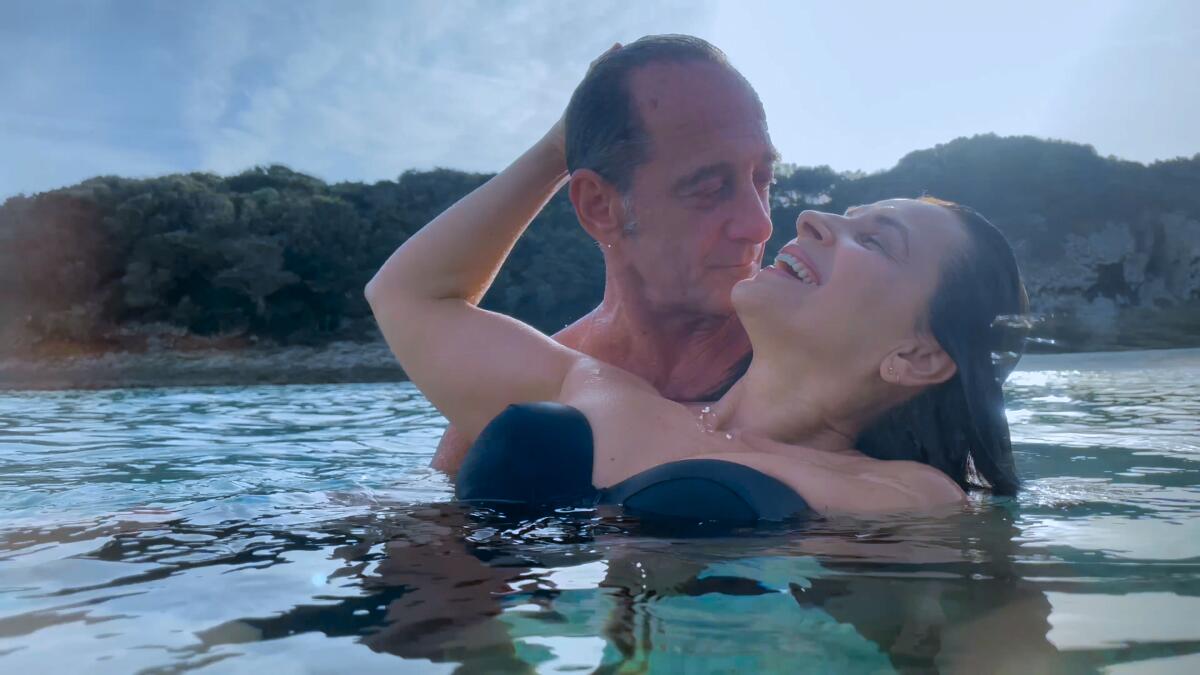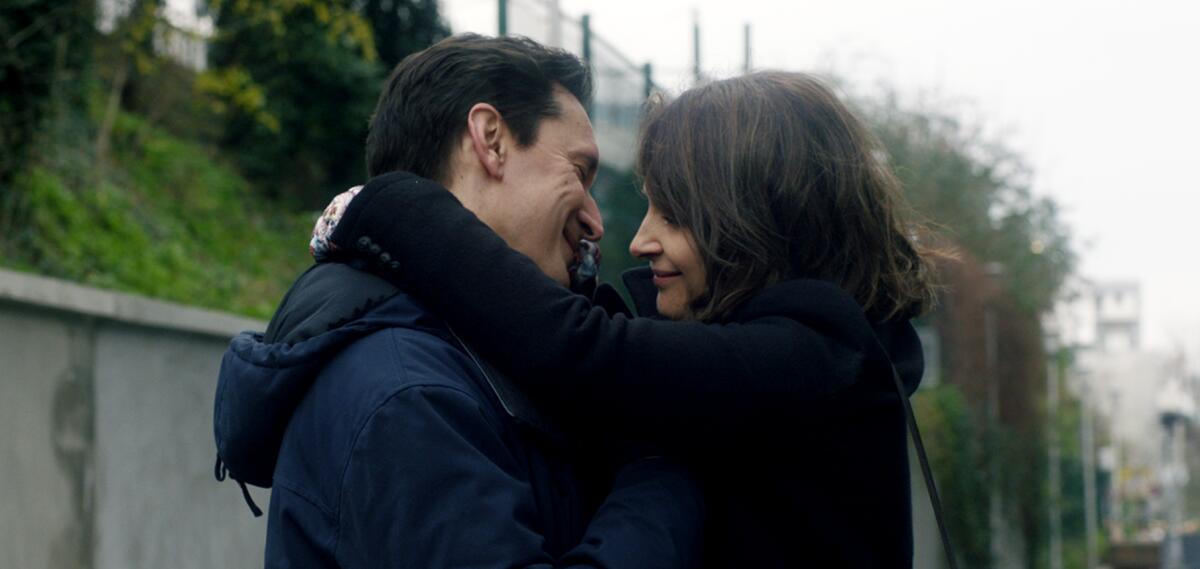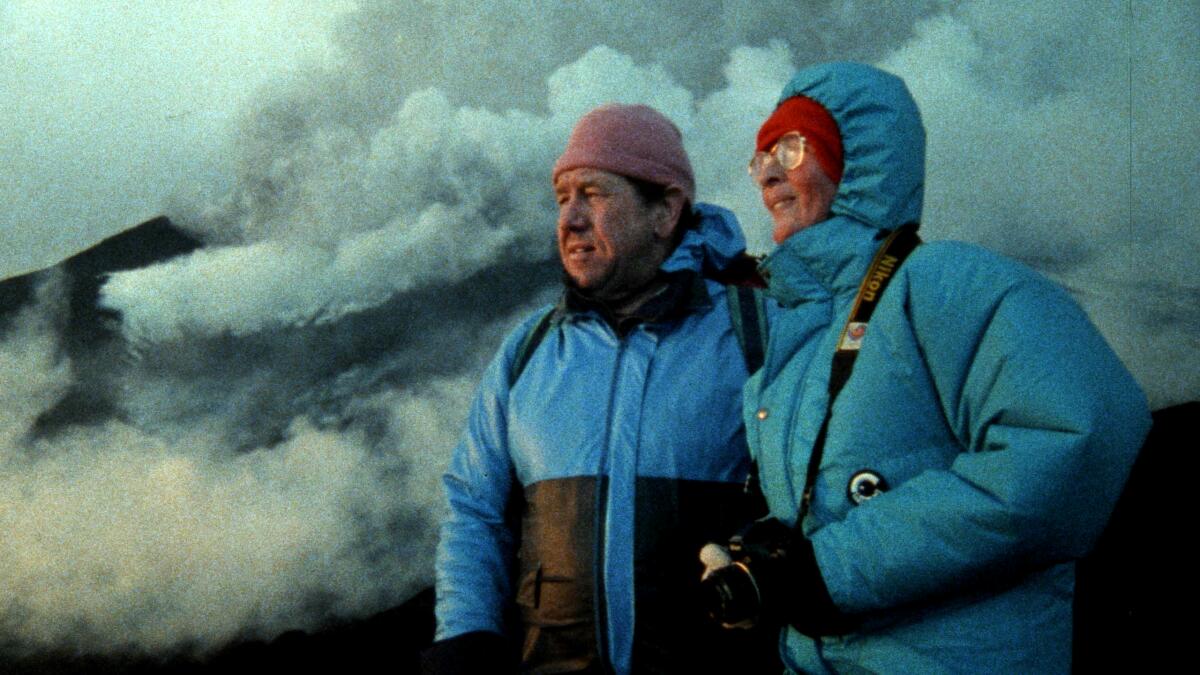Mature romantic melodrama in ‘Both Sides of the Blade’

- Share via
Hello! I’m Mark Olsen. Welcome to another edition of your regular field guide to a world of Only Good Movies.
Only good movies
Get the Indie Focus newsletter, Mark Olsen's weekly guide to the world of cinema.
You may occasionally receive promotional content from the Los Angeles Times.
James Caan is remembered. An Academy Award nominee for his performance as Sonny Corleone in “The Godfather,” James Caan died this week at age 82. Though perhaps thought of as a movie tough guy, he had a remarkably varied career that reached generations of film fans, with roles in films including “The Gambler,” “Misery,” “Bottle Rocket,” “Honeymoon in Vegas,” “Elf” and many more.
Mary McNamara remembered his role in the tear-jerker sports movie “Brian’s Song,” in which Caan played NFL player Brian Piccolo opposite Billy Dee Williams as Gayle Sayers. As Mary wrote, “It was a film with a social conscience — the historic interracial aspect of the men’s friendship was an obvious and, at the time, quite risky theme. Caan and Williams brought Piccolo and Sayers instantly and intensely to life (Caan managed to do this while wearing white socks and penny loafers and uttering, with apparent sincerity, words like ‘golly’), and their bond, built on competition and mutual respect, was a hopeful sign after a decade of righteous racial protest.”
The last word on Caan can go to Michael Mann, who directed the actor to one of his most memorable performances in the film “Thief.” In a statement released after Caan’s death, Mann said, “Jimmy was not just a great actor with total commitment and a venturesome spirit, but he had a vitality in the core of his being that drove everything from his art and friendship to athletics and very good times. There was a core of values within him about how people should be, more or less. It might be variable, the corners could be rounded with urban irony, but there was a line and it was non-fungible.”
Florida swamp noir. Monday sees a double bill of lurid Florida-set swamp noir at the New Beverly. John McNaughton’s 1998 “Wild Things” stars Neve Campbell, Denise Richards, Kevin Bacon and Matt Dillon in a tale of double-crosses and schemes gone wrong. When you hand over an erotic thriller to the person who made “Henry: Portrait of a Serial Killer,” buckle up. And then Lee Daniels’ 2012 “The Paperboy” stars Nicole Kidman, Zac Efron, Matthew McConaughey, John Cusack and David Oyelowo in a sweaty, pulpy saga of murder and more. This will be a good night out at the movies, guaranteed.
VHS lives on. Jenn Swann paid a visit to Whammy! Analog Media (WAM for short), the VHS-centric video store that opened in L.A.’s Echo Park earlier this year. Co-founder Jessica Gonzales spoke about how the store and its screenings have tapped into a community of fans. As she said, “Everyone calls VHS a dead medium. It’s literally the opposite. It’s literally alive compared to a digital file or a DVD. When you have a bloop at the point in a movie that’s [otherwise] way too perfect, or you have a scratch here or there, or it drops in frames, like, that is alive.”
Enjoying this newsletter? Consider subscribing to the Los Angeles Times
Your support helps us deliver the news that matters most. Become a subscriber.
‘Both Sides of the Blade’
Veteran French filmmaker Claire Denis has seen a much-deserved uptick in attention and acclaim over the last few years. Her latest film, the mature romantic melodrama “Both Sides of the Blade,” picked up a directing prize for Denis when it premiered earlier this year at the Berlin Film Festival. Juliette Binoche and Vincent Lindon are Sara and Jean, a couple who find their quiet life upended by the reappearance of François (Grégoire Colin), an old flame of Sara’s with a business proposition for Jean. The film is playing in limited release and available on demand Aug. 23.
For The Times, Justin Chang wrote, “All this may sound like unusually straightforward, soapy material for Denis, a filmmaker known for her jagged, elliptical narratives and confrontational subject matter. Yet while ‘Both Sides of the Blade’ may unfold in more linear fashion than, say, her brutally transgressive sex-in-space odyssey, ‘High Life,’ it is nonetheless born of the same searching, exploratory spirit. Watching it, you can feel Denis zeroing in on the conventions of the bourgeois French melodrama with something resembling a lover’s playfulness; she wants to rough them up, test their limits and bend them into challenging new configurations. … Maybe life is a melodrama, this movie suggests. Or maybe melodrama is closer to life than we realize.”
Justin also wrote a handy catch-up guide to Denis’ films available on streaming for the Screen Gab newsletter.
For the New York Times, A.O. Scott wrote, “The dissonance between the film’s structure and its tone is potentially interesting, and the off-balance intensity of the performances means that ‘Both Sides of the Blade’ is never dull. As they did in ‘Let the Sunshine In,’ Binoche and Denis trace the disruptive effects of desire on a woman who is neither heroine nor victim. The impulses that lead Sara to destabilize her own domestic life are mysterious even to her, and the audience may wonder why she appears to prefer François, who is pouty and petulant (even in bed), to the stoical, sad-eyed Jean. Bad choices often make good stories, but there is something thin and tentative about this one.”
For the New Yorker, Richard Brody, using the film’s alternate title, “Fire,” wrote, “There’s a pugnacious bluntness, a weighty physicality to the movie’s images (the cinematographer isn’t Denis’s longtime collaborator Agnès Godard but, rather, Éric Gautier); Denis films the heft and the age of her characters’ bodies, shows her protagonists in extreme closeups that fill the theatre with sweat and cologne, conveying a sense of electric shock at the connection of glances. The ambient anguish is intensified by the movie’s present tense in the time of covid, with masks as standard equipment and proof of vaccination a part of office life. … The silences that overwhelm the movie’s confrontational rages and the suppression of backstory details, underplaying motives and emphasizing action, thrust ‘Fire’ out of the realm of psychological drama and into shocking emotional immediacy.”
For the Playlist, Jessica Kiang wrote, “This is Marie’s show. And Binoche’s Marie, while an asset to the film’s watchability, might also be the conundrum most crippling for its believability. Whatever about her being distracted by an obviously untrustworthy François when decent, devoted Jean is so much more appealing a prospect (and Lindon can break your heart a little with the sincerity he brings to a speech about why he likes to drive out to a particular supermarket to do the grocery shopping) — French love-triangles gonna French love-triangle, I guess. Even so, though, the intensity of her dilemma is severely undercut by how ultimately selfish it is. Marie never seems particularly interested in either man except for how they are interested in her and is revealed to be so self-centered in her pursuit of amours both fou and entirely rational, that she is far less likable than Binoche’s disingenuously bright-eyed and forthright performance can account for. There she is, sliding, as Stuart Staples croons crookedly as the credits roll, down both sides of the blade, but it’s hard to imagine and harder to care whether the dagger will actually find her heart.”

‘Fire of Love’
Directed by Sara Dosa, the documentary “Fire of Love” tells the story of French volcanologists Katia and Maurice Krafft, who traveled the world studying volcanoes and making films of their adventures until their deaths in 1991. With narration by Miranda July, chockablock with quaintly antiquated technology and gadgetry and a romantic, off-kilter sensibility drawn from Agnès Varda and Wes Anderson, the film is in limited release.
For The Times, Justin Chang wrote, “As its title makes clear, the movie also seeks to cast the Kraffts as well-matched leads in a most unusual love story, one that found its grandest consummation in jaw-dropping eruptions of lava and ash. ‘Fire of Love’ is sometimes a romantic comedy, predicated on the affable TV-friendly chemistry between the grinning, gregarious Maurice and the petite, birdlike Katia. By the end, when it recounts its subjects’ deaths in the 1991 eruption of Mt. Unzen in Japan, the story has morphed into something more somber, though the Kraffts themselves might have stopped short of calling it a tragedy.”
For RogerEbert.com, Matt Zoller Seitz wrote, “It is never more graceful and on-point than when it’s serving up a succession of nature images captured by the Kraffts: a still image of a hand caressing ripples in black earth; expressionistic shots of lava-fountains spewing; underwater images of red-hot magma extruding and then cooling and hardening. ‘Fire of Love’ has an identity that is connected to, yet independent of, the information it delivers. Pedro Almodóvar once advised new filmmakers that it isn’t enough for a film to move: it needs to dance. This movie dances. You could project it on the wall of a nightclub.”
For the Playlist, Carlos Aguilar wrote, “In between the blurred lines at the junction of their intimate bond and their intellectual partnership, what [peeks] through as a shared philosophical position is their [disillusionment] with humanity — our propensity for waging war on each other and the decision makers’ disregard for life-saving information — as well as their efforts to reconnect with people. As much as we learn about the erratic behavior classification of these massive mounds of grunting gas, rock, and pressure (divided mainly between red and gray volcanoes, the latter being the more hazardous), the fuel of ‘Fire of Love’ is their magma-proof adoration for each other and what they’ve laid eyes on. The Krafft’s globetrotting love story exists at its most ardent in proximity of their mutual passion.”

‘Thor: Love and Thunder’
Directed and co-written by Taika Waititi, “Thor: Love and Thunder” continues the irreverent reading of the superhero movie that Waititi began with “Thor: Ragnarok.” This time out, Thor (Chris Hemsworth) finds himself battling alongside his earthly ex-girlfriend, Dr. Jane Foster (Natalie Portman), who now wields Thor’s old weapon, Mjölnir. The cast includes Tessa Thompson, Christian Bale, Waititi and a raft of appearances by the likes of Russell Crowe, Chris Pratt and others. The film is in wide release.
For The Times, Justin Chang wrote, “The movie tries to both mock and burnish Thor’s legend with a series of zippy once-upon-a-time montages that recap the character’s ups and downs, his losses (Loki!) and loves (Jane, among others), and his unusual number of physical makeovers, from ‘Ragnarok’s’ dashing textured-crop-and-eyepatch look to that ‘Endgame’-era beer belly. It’s enjoyable for a while to relive all this. Thor’s sometimes rudderless evolution over the years speaks to the trickiness of a character that even the well-oiled Marvel machinery hasn’t always been able to crack. It also speaks to the sustaining warmth and versatility of Hemsworth’s star presence, his ability to remain good company even when the movies themselves haven’t been good.”
Sonaiya Kelley explored the film’s treatment of the character of Jane Foster, played by Natalie Portman, who returns to the story after sitting out “Ragnarok.” For Portman, being allowed to step into the power of Thor was particularly exciting, as she said, “To get to be a superhero at all is such a rare opportunity [for an actor]. Certainly getting to be one as you’re turning 40 is pretty much unheard of. It’s not anything that I dreamt I would get to do.”
In a separate story publishing soon, Sonaiya spoke to Hemsworth, Portman and Thompson about what Waititi and his use of improvisation bring to the MCU. As Thompson said, “I love it because it also gives you so much agency to write character. Sometimes you have the ability in improvisation to really flesh out elements of your character that just don’t exist on the page, and certainly there was the opportunity to do that this time around. Taika pitched me some things early on, I got to pitch him back, and it was nice to be more integral to the process of figuring out how she might have grown as a character since we saw her last. It’s also just so fun to see the imagination of my friends.”
For the New York Times, Manohla Dargis wrote, “‘Love and Thunder’ is sillier than any of its predecessors, and thinner. A lot happens in overstuffed Marvel Studios fashion. But because the series has jettisoned many of its earlier components — its Shakespearean pretensions, meddlesome relatives and, crucially, Thor’s godly grandeur — the new movie more or less plays like a rescue mission with jokes, tears and smackdowns.”
For Vanity Fair, Richard Lawson wrote, “There is no sense of occasion or larger narrative meaning to be found in ‘Love and Thunder.’ It’s simply a vignette-y ramble, a hyper-colored string of gags that never land. In days past, I might have yearned for a Marvel movie that felt so standalone, unconcerned with tying itself into whatever larger mythos the studio was coalescing into an ‘Endgame’-esque event film. But I suppose I have become inured to the idea that all of these movies are headed somewhere of consequence — and in that sense, ‘Love and Thunder’ is a total waste of time.”

Only good movies
Get the Indie Focus newsletter, Mark Olsen's weekly guide to the world of cinema.
You may occasionally receive promotional content from the Los Angeles Times.




